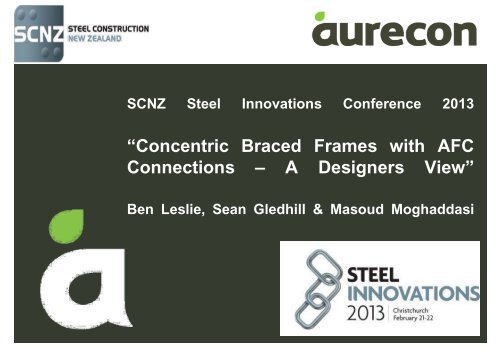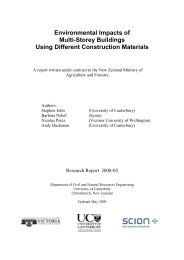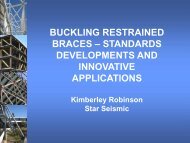Paper 6 SCNZ - Powerpoint - AFC Connections - A designers View
Paper 6 SCNZ - Powerpoint - AFC Connections - A designers View
Paper 6 SCNZ - Powerpoint - AFC Connections - A designers View
Create successful ePaper yourself
Turn your PDF publications into a flip-book with our unique Google optimized e-Paper software.
<strong>SCNZ</strong> Steel Innovations Conference 2013<br />
“Concentric Braced Frames with <strong>AFC</strong><br />
<strong>Connections</strong> – A Designers <strong>View</strong>”<br />
Ben Leslie, Sean Gledhill & Masoud Moghaddasi
Presentation Overview<br />
• Evolution towards Low Damage Design for CBF’s<br />
• Asymmetric Friction Connection (<strong>AFC</strong>) Concept and<br />
Configuration<br />
• Key Design Considerations for <strong>AFC</strong>’s - Existing Theory<br />
and Developments Between Industry and Research<br />
• Key Benefits of <strong>AFC</strong>’s over other CBF Systems<br />
• Conclusions and Summary
Evolution towards Low Damage Design for CBF’s<br />
(a) Traditional Ductile CBF’s<br />
• Ductility achieved through compression buckling of brace<br />
- High damage to brace<br />
- Difficult to predict overstrengths<br />
- Limited resilience to large cycles of earthquakes/aftershocks<br />
• Due to less favourable buckling response, NZS3404 requires:<br />
- Braces in Pairs<br />
- Maximum height limitations<br />
- Increased seismic demand (Cs factor)<br />
Sciencedirect.com<br />
• Need for a system which:<br />
- Protects brace from buckling<br />
- Dissipates energy through another mechanism
Evolution towards Low Damage Design for CBF’s<br />
(b) Buckling Restrained Braces (BRB’s)<br />
• Steel insert in grouted restraining tube<br />
• Energy dissipation through tension – compression<br />
yield of steel insert, without buckling<br />
• Reliable hysteretic response with limited slip<br />
Starseismic.net<br />
• Designers can reliably predict overstrength so can<br />
de-tune member categories for design<br />
• Prone to high residual drifts<br />
• Expense to import proprietary systems prohibitive<br />
Starseismic.net
Evolution towards Low Damage Design for CBF’s<br />
(c) Asymmetric Friction <strong>Connections</strong> (<strong>AFC</strong>’s)<br />
• Need for local innovation to reduce cost<br />
• <strong>AFC</strong>’s Conceptualised with SHJ development<br />
• Central cleat slides between two shim plates and<br />
dissipates energy through friction<br />
• Bolts slide in elongated holes in central cleat<br />
• Ductility concentrated in connection through sliding,<br />
protects brace, beam and column from inelastic action<br />
Chanchi (2012)
Asymmetric Friction <strong>Connections</strong>–Concept and Configuration<br />
Proposed <strong>AFC</strong> configurations for CBF<br />
frames (Chanchi et. al. (2012).
Asymmetric Friction <strong>Connections</strong>–Concept and Configuration<br />
<strong>AFC</strong> frame details from<br />
Aurecon <strong>SCNZ</strong> Case Study<br />
Building Design.
Asymmetric Friction <strong>Connections</strong>–Concept and Configuration<br />
• Stable elasto-plastic<br />
hysteresis<br />
• Good stiffness and strength<br />
stability after large number of<br />
cycles<br />
• Variety of shim materials<br />
tested (Brass, Steel,<br />
abrasion resistant steel)<br />
• High hardness, abrasion<br />
resistant steel produces<br />
most stable response<br />
(Chanchi et. al. (2012).
Key Design Considerations for <strong>AFC</strong>’s - Existing Theory and<br />
Developments Between Industry and Research<br />
(a) Slot Detailing<br />
• Slot length “L” is determined from frame<br />
geometry and drift<br />
• Slot length must accommodate brace<br />
displacement at MCE + construction<br />
tolerance (±25mm is proposed)<br />
• Oversizing of slotted holes is advised to<br />
create “pinned” brace end<br />
db<br />
=<br />
L = φs<br />
× ( 2db<br />
+ d )<br />
H<br />
2<br />
+<br />
2<br />
( S + Δ) − B<br />
(Chanchi et. al. (2012).
Key Design Considerations for <strong>AFC</strong>’s - Existing Theory and<br />
Developments Between Industry and Research<br />
(b) Joint Yield Strength<br />
Bolt Arrangement<br />
Dependable Sliding Force ΦFs<br />
4/M16 128 kN<br />
• Sliding force, F s , is function of effective<br />
friction coefficient “μ”, number of shear<br />
planes “n” and bolt proof load “N tf ”.<br />
2/M16 and 2/M20 162 kN<br />
4/M20 195 kN<br />
2/M20 and 2/M24 238 kN<br />
F s = μ . n . N tf<br />
μ = 0.21 – MacRae (2005)<br />
n=2<br />
N tf = table 15.2.5.1 NZS 3404<br />
Strength reduction factor Φ=0.80<br />
• Range of connection strength achieved<br />
with mixed bolt sizes<br />
4/M24 282 kN<br />
4/M20 and 2/M24 336 kN<br />
4/M24 and 2/M20 380 kN<br />
6/M24 423 kN<br />
4/M24 and 4/M20 477 kN<br />
6/M24 and 2/M20 521 kN<br />
8/M24 565 kN
Key Design Considerations for <strong>AFC</strong>’s - Existing Theory and<br />
Developments Between Industry and Research<br />
(c) Capacity Design<br />
• Overstrength factor Φ os =1.4 (Accounts for connection strength increase,<br />
variation in bolt tightening and environmental effects).<br />
• Brace and collector beam designed as Cat. 3 with slenderness < 120<br />
• Column designed as Category 2 Member<br />
• Maximum Ductility is determined considering “No Sliding” SLS seismic and ULS<br />
wind requirement (C dT,ULS > C dT,SLS & ULS Wind).<br />
• <strong>AFC</strong> Slot length must accommodate MCE brace displacement ±25mm<br />
tolerance.
Key Design Considerations for <strong>AFC</strong>’s - Existing Theory and<br />
Developments Between Industry and Research<br />
(d) Connection Component Design<br />
• Brace must be designed for combined axial load and bending moment from<br />
connection eccentricity<br />
• <strong>AFC</strong> cleats designed in accordance with HERA Report R4-142:2009 Eccentric<br />
Cleats in Compression.<br />
• Stiffening of cleats is likely to be require, to ensure lateral stability under<br />
compression loading and to transfer bending moments through the connection<br />
and into the brace
Key Design Considerations for <strong>AFC</strong>’s - Existing Theory and<br />
Developments Between Industry and Research<br />
(e) Connection Installation Considerations<br />
• Provide Belleville springs between bolt heads and outside plates is recommended<br />
- Minimises variability in bold sliding forces<br />
- Reduces elastic strain losses<br />
• Use hardened abrasion resistant steel shims in <strong>AFC</strong>’s<br />
- More stable hysteresis than brass or mild steel<br />
- Limited to interior or weather proofed applications, corrosion issues with shims in<br />
exposed conditions<br />
• Bolt Tensioning Procedure is Important<br />
- Tensioning to proof load considering washers need to be flattened<br />
- Bolts are snug tightened then tensioned a further 120°(Part Turn Method)
Key Benefits of <strong>AFC</strong>’s over other CBF Systems<br />
• Inelastic behaviour concentrated in the brace connection – high degree of<br />
protection to the brace, beam and column<br />
• Non-linear response and overstrength is more reliably predicted<br />
• Relaxation of design forces and slenderness requirements can be applied<br />
• Significantly less severe beam and column design actions by avoiding brace<br />
buckling<br />
• Ability to assess and recover primary seismic frame in a reasonably timely<br />
manner (bolt/connection inspection and bolt re-tightening/replacement)
Key Benefits of <strong>AFC</strong>’s over other CBF Systems<br />
Post Earthquake Recovery of <strong>AFC</strong> Frame Buildings<br />
- Building can be assessed and recovered in a relatively timely manner<br />
- <strong>Connections</strong> require inspection to assess the extent of sliding after a significant<br />
earthquake<br />
- If sliding in the connection has been activated, bolts will require re-tightening are<br />
but unlikely to require replacement<br />
- Plan inspection port locations within architecture to allow ease of inspection and<br />
recovery of <strong>AFC</strong> connections
Conclusions and Summary<br />
• Reliable inelastic behaviour without brace buckling<br />
• Reliable source of energy dissipation with stable response<br />
• Connection is easily tuned to meet ductile demand = capacity design efficiencies<br />
• Lower loads and improved efficiency for brace, collector beam and column<br />
• Better performance and resilience by avoiding brace buckling<br />
• Local and innovative NZ alternative to expensive imported solutions
Acknowledgements<br />
• Sean Gledhill and Masoud Moghaddasi (Aurecon)<br />
• Jose Chanchi (The University of Canterbury)<br />
• Greg MacRae (The University of Canterbury)<br />
• Charles Clifton (The University of Auckland)<br />
• Hsen Han Khoo (The University of Auckland)<br />
• Steel Construction New Zealand (<strong>SCNZ</strong>)

















